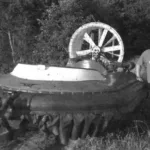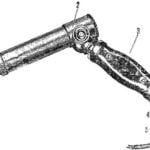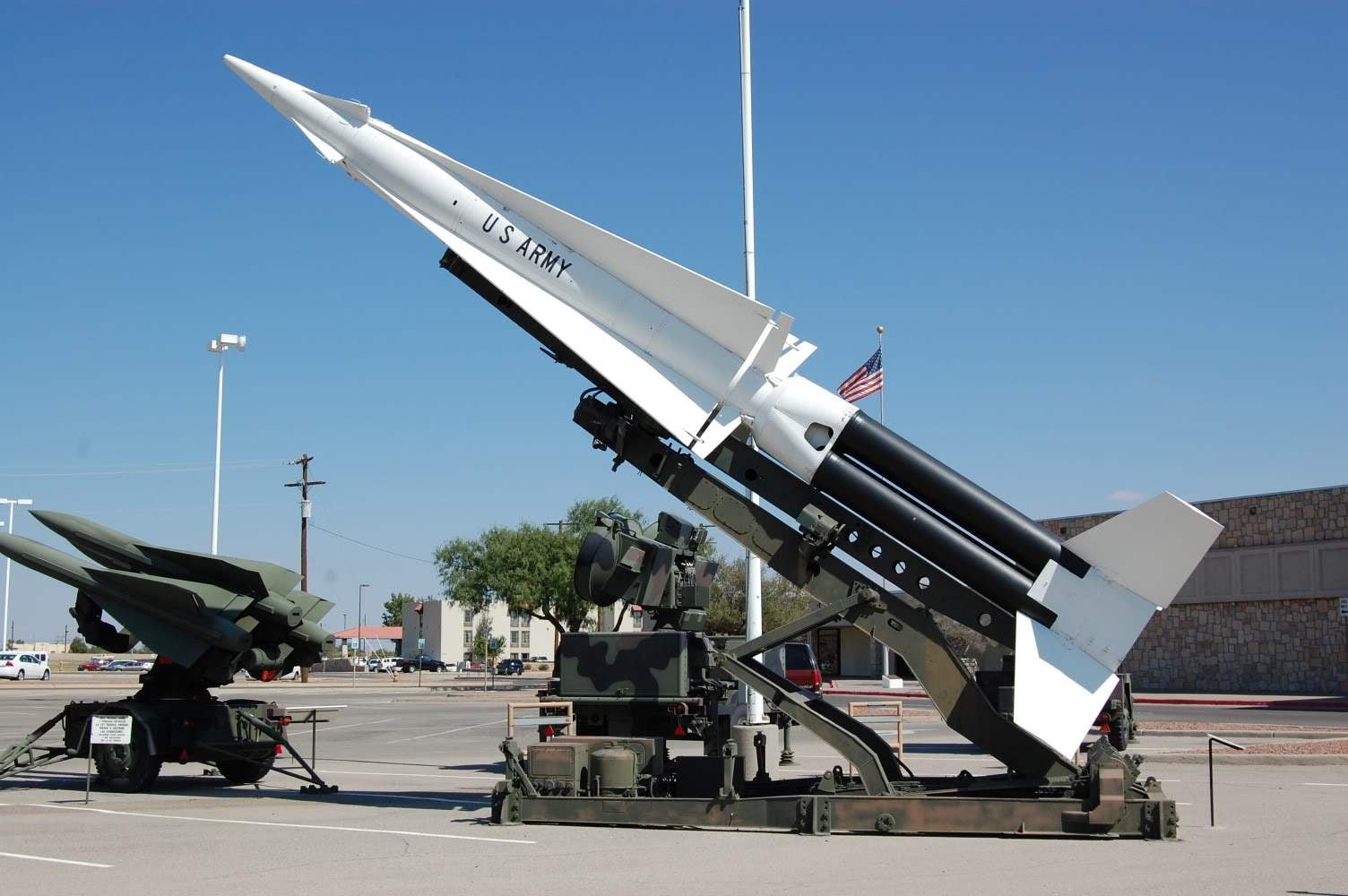 Anti-aircraft interceptor missile NIKE-HERCULES MIM-14B. Source options for most anti-aircraft missiles designed in the 1950s “on both sides of the ocean”, become missiles manufactured during the Second world war in Germany. Despite the fact that the German “wasserfall”, “schmetterlinge”, “rheintochter”, etc. do not have time to participate in combat operations, their prospects as a new type of weapon was not subject to any doubt. But after a careful study of the Germans captured samples of the rockets and documentation there are new technical capabilities to create such weapons. The more targets for them has become more serious in developing the “cold war” anti-aircraft missiles would become an insurmountable obstacle in the way of bombers with nuclear bombs.
Anti-aircraft interceptor missile NIKE-HERCULES MIM-14B. Source options for most anti-aircraft missiles designed in the 1950s “on both sides of the ocean”, become missiles manufactured during the Second world war in Germany. Despite the fact that the German “wasserfall”, “schmetterlinge”, “rheintochter”, etc. do not have time to participate in combat operations, their prospects as a new type of weapon was not subject to any doubt. But after a careful study of the Germans captured samples of the rockets and documentation there are new technical capabilities to create such weapons. The more targets for them has become more serious in developing the “cold war” anti-aircraft missiles would become an insurmountable obstacle in the way of bombers with nuclear bombs.
The undisputed leader in these works was the American system of Nike, which began on 8 February 1945, the day artillery Directorate of the U.S. army commissioned the company “Western electric” research, scientific experiments and technical development of the missile, intended for use as “offensive air defense” of the major cities in the United States. From the standpoint of the mid-1940s, such a contract in America no one was considered neither as urgent nor as extraordinary. Monopoly possession of nuclear weapons allowed the Americans not to give much thought to an effective defense. However, over time, Americans have lost the confidence in the immutability of this situation, and attitude toward the project beginning to undergo a radical change. That caused a shock among us military and technical experts test the first Soviet atomic bomb was made much to raise the status of improvements to air defense systems, which was immediately ranked among the “crucial tool in the war and for deterrence of nuclear attack”.
As a result, a new weapon system every month began to receive an increasing priority, and the constantly increasing pace of work, and demonstrated the desire of the American leadership to protect from air strikes by the largest political, administrative and industrial centers of the United States, naval base, airfields and other military installations.
Missile “Nike”, the basic works on creation of which was designed by the famous aircraft firm “Douglas”, was originally designed for two-stage — solid propellant booster and sustainer stage with the liquid rocket engine (LRE) of the firm “Aerojet”. For this rocket engine was used red fuming nitric acid and kerosene JP4, and the launch was carried out with a mixture of aniline and furfuryl alcohol (later replaced by unsymmetrical dimethylhydrazine).
The first version of the accelerator consisted of eight small solid rocket motors (TRD), evenly spaced in a circle at the tail part of sustainer stage. This variant of “Nike” for the first time tested in September 1946 at the site white Sands.
But in the future, “Nike” was used single tandem positioned rocket engine, developed by specialists of the firm “Gudiyr”, “Hercules” and Redstone Arsenal. The engine develops a thrust of up to 27 tons and had about 3 s. This was enough for the missile had a launch weight of approximately 1120 kg, in the active phase of flight when operating a rocket engine could reach supersonic speeds up to M = 2,3. Its range was up to 46 km, and the height of defeats the purpose — 21 -22 km.
Combat gear weighing about 140 kg consisted of three parts, is located in the bow, middle and aft parts of the rocket.
Given the high rate tests, the contract to build the first of a series of 100 missiles “Nike” the Ministry of defense of the United States signed in January 1951, before getting the first results in the interception of aerial targets. In October 1951 the first rocket prepared to launch with a full complement of control equipment. In the early 1950s, the characteristics of these missiles was estimated high enough. The first attempted interception took place on 27 November 1951 and proved successful — the missile hit the aircraft target S-17 — RC version of the “flying fortress” b-17. Following a further 22 successful launches — three of which performed at ground targets and the rest at air targets is allowed to begin preparation for military deployment around major American cities. In July 1952, earned a production line of missiles, and in January of the following year formed the first missile battery.
30 may 1954 the first battery of Nike missiles, the designation MIM-3, took over day and night combat duty in Fort Meyde. This date was later celebrated as the birthday of “Nike”.
By early 1955 the anti-aircraft missile system “Nike” has placed around most major US cities. Only 350 of the complexes, and the number released by “Douglas” missiles was 13,714.
However, made in such huge quantities, the missiles never had to come to grips with the enemy, because of the intrusion into the airspace of America was not, and the only known fact of their combat use began fighting in the early 1960s in the skies over Taiwan, during which the “Nikes” was shot down several Chinese reconnaissance aircraft.
But in General the effectiveness of “Nike axov” (as these missiles became known as from the end of 1956) were significantly lower than expected, even when the training starts. Of particular prominence was the unfortunate shooting at the aircraft-missile “Matador”, held in October 1955 at the site white Sands. During the first series launches of “the Matador” flying at a height of 10,600 m at a speed of 960 km/h, it was released 4 missiles, and none of them hit the target. Equally unsuccessful was the attack on the second Matador. Only on the third attempt, the target was finally hit by two missiles.
Such a discouraging result, significantly changed the attitude to “Nike”. Has failed to improve his reputation and a successful firing, which were held in may 1956 in the presence of specially invited journalists. This time there were seven successful launches out of eight.
However, in March 1952, the analysis made by specialists of the Ministry of defense, showed rather limited action of “Nike” against dense groups of bombers. As a result, on 16 July 1953, it was decided to start developing a new missile “Nike” (“Nike-Hercules”), and has greatly increased warhead and capable of intercepting air targets flying at speeds of about 2000 km/h, at ranges over 50 km and altitudes over 20 km.
The development of this missile also performed firm “Douglas”. The original plans envisaged the establishment of a “Nike-Hercules” based on the elements “Nike Ajax”: to start the rocket was using the accelerator M42, consisting of four starting motors “Nike-Ajax” М5Е1 General thrust of about 98 tons, and for the further flight of four propulsion rocket engine. At the same time for “Nike-Hercules” have taken a different aerodynamic design. In contrast to the scheme “duck”, used to “Nike-Ajax”, the new missile has four crosswise arranged triangular wing of small aspect ratio and large sweep on the leading edge. Behind the rear edge of the wings installed the elevons provide control of the rocket flight. In the nose of the rocket in the same plane as the wings were small triangular destabilizers antennas. This aerodynamic design has greatly enhanced the agility of the missile, especially at high altitudes.
Use for “Nike-Hercules” worked previously propulsion allowed extremely fast to begin flight tests of the new rocket. Its first launch took place on 13 January 1955 However, at the same time simplify the problem, the use of such a large number of propulsion systems has led to a significant reduction of the reliability of the rocket. As a result, 20 of the first 12 launches were unsuccessful, mainly due to the failure of one or more propulsion rocket engine. Finally a line under by using bundles of four rocket engine for the sustainer stage of the rocket failed accident during testing, which occurred September 30, 1955, when on the stand exploded one of the engines.
The new version of the missile included the use of its sustainer stage specially developed by the firm “Tiokol” marching solid engine with a thrust of 4.5 tonnes and a length of about 70 C.
The first launch of the “Nike-Hercules” with the new sustainer engine was held on 13 March 1957, By which time the asset of the new system has already been recorded the first interception of aerial targets flying at a speed of about 2700 km/h at an altitude of 20 km, completed on 31 October 1956 the former (four-engine sustainer stage) variant of the missile.


![Anti-aircraft guided missile]()
Anti-aircraft guided missile “Nike-Hercules” MIM-14B:
1 — the stabilizer; 2 — rear bracket; 3 — the primary site of fastening of the stabilizer; 4 — solid-propellant motor of the accelerator М5Е1; 5 — front yoke; 6 — transition skirt Windows and exhaust of the main engine; 7 — node connections of the accelerator to the sustainer stage with the elevon lock on the starting phase of flight; 8 — elevon; 9 — anti-flatter load; 10 — wing; 11 —marching solid engine М42А1; 12 — operational hatch compartment of military equipment; 13 — nozzle of the starter motor; 14 — the aft fairing of the accelerator; 15 — coupling; 16 — fairing exhaust device of an onboard power unit (auxiliary power unit); 17 — antenna radio command guidance system; 18 — receiver air pressure; 19 — destabilizer; 20 — fairing; 21 maintenance hatch compartment command guidance system; 22 — on-Board connector; 23 — Luke safety-Executive mechanism of the warhead
In General, during the tests, which lasted until October 1959, launched about 300 rockets. The launches were carried out in a variety of weather conditions on targets that had different characteristics — in size, speed and altitudes. On the qualities the new missile is much superior predecessor. So, with the launch mass 4850 kg “Nike-Hercules” (SAM-A-25, MIM-14) could fly at speeds up to M = 3,65 and hit supersonic aerial targets at ranges up to 150 km and altitudes up to 30 km. High destruction efficiency provided by the presence of a powerful rocket high-explosive warhead (M17 or M135) weight kg 502,7 besides the possibility of missiles could be increased by equipping it with the W31 nuclear warhead with an adjustable power level. At level M-97 power was 2 CT, M-22 — 20 CT and M-23 — 40 CT. Missile “Nike-Hercules” was designed for operation in temperatures ranging from -40° to +50°C when placed the starting position at altitudes up to 2 km above sea level, with winds of up to 30 m/s.
Launched the “Nike-Hercules” with single-shot launchers (PU) with the guide of finite length. There are three modifications of PU — stationary, semi-mobile and self-propelled. The first two provided the rocket at a constant elevation of approximately 90°.
Self-propelled launcher mounted on a wheeled chassis М520 — truck high flotation of the company “caterpillar”, was an experienced and tested. Chassis PU wheel had the formula 2×2.
М520 consisted of two uniaxial sections hinged together. Large diameter wheels provide the chassis of high passability. In the front section housed the driver’s cab and the engine in the rear — the actual launcher.
PU consisted of four main units: artillery units — with the guide mechanism of vertical guidance; a retractable wheel landing gear for landing it on the ground and eliminate rocking of the installation during the launch; reflector flowing gases the booster with mount and a set of hydraulic jacks and supports for levelling the base of the installation in the firing position.
Patient placement systems, “Nike Hercules” was included in the composition of batteries and battalions. Battery had all the means of combat air defense missile system and two launch pads, on each of which there were four launchers with missiles. The battery is usually around the defended object at a distance of 50 — 60 km from the centre, usually in conjunction with batteries AAMS medium-range “hawk” Division consisted of six batteries.
The original plan had envisaged a missile “Nike-Hercules” replace “Nike-Ajax” in the early 1960s, however, unsuccessful career “axaw” forced to significantly accelerate the pace of work. And the first “Nike-Hercules” was introduced into operation on 30 June 1958 in the district of new York, Philadelphia and Chicago. Just launched the 145 positions to accommodate the new complex, of which 110 were prepared in replacement for them “Nike axow”. Simultaneously with the submission of the “Nike-Hercules” began to appear with weapons missile “Nike-Ajax”. the last of the equipped complexes were about Norfolk and graduated from combat duty in November 1963.
However, the effectiveness of the “Nike-Hercules” turned out to be not as high as expected in the initial stages of the work. She also became the subject of considerable discussion in the United States, especially after receiving the results carried out in 1959 mathematical modeling of the reflection of an air RAID on Chicago. Fulfilled calculations have shown that, despite their efforts, the effectiveness of the new air defense system is only 8%. Following this, the defense system of cities in the United States, created on the basis of the missile “Nike-Ajax” and “Nike-Hercules” was heavily criticized in a Senate Committee on armament. As a result, had cancelled the earlier permission for the creation of 50 missile bases, air defense and, accordingly, reduced the provision for production of missiles.
In these circumstances, work on the development and modernization of the “Nike-Hercules” again crossed. The result of the improved rocket has acquired the ability to hit not only aircraft, but also tactical ballistic missiles moving at speeds of up to 4400 km/h. it was Noted that in one of the trials, held in late 1959 at the landfill white Sands, “Nike-Hercules” intercepted a supersonic target at a height of 45.7 km, And in 1960 there has intercepted several ballistic missiles, including tactical ballistic missile “Corporal”.
Total produced more than 25 thousand “Nike-Hercules”, a large part of which in the embodiment М1М-14V. Besides the United States they license produced in Japan. During the 1960 -1970 those missiles was one of the most widespread in the world air defense systems that were in service almost all States, NATO and many U.S. allies in Asia.
In 1974, “Nike Hercules” began to retire in the United States. The last rocket in 1978 — 1979 left the starting position, is located in Alaska and Florida.
By the beginning of the XXI century, these missiles remained in service with air defense only in Greece, Turkey, Italy and South Korea, where they are gradually replaced with more modern samples.
V. KOROVIN
Recommend to read
 AMPHIBIAN ON BED
AMPHIBIAN ON BED
We present a prototype of the amphibious machine is a device hovercraft (Ohr) under the name "Aerodzhip", publication of which was in the journal "modelist-Konstruktor" No. 7 for 2007.... BURNER WITHOUT FIRE…
BURNER WITHOUT FIRE…
By analogy with existing devices for welding and brazing working "with the light", this device is also called a burner. However, it acts on the mating parts do not flame, and hot air...
 Anti-aircraft interceptor missile NIKE-HERCULES MIM-14B. Source options for most anti-aircraft missiles designed in the 1950s “on both sides of the ocean”, become missiles manufactured during the Second world war in Germany. Despite the fact that the German “wasserfall”, “schmetterlinge”, “rheintochter”, etc. do not have time to participate in combat operations, their prospects as a new type of weapon was not subject to any doubt. But after a careful study of the Germans captured samples of the rockets and documentation there are new technical capabilities to create such weapons. The more targets for them has become more serious in developing the “cold war” anti-aircraft missiles would become an insurmountable obstacle in the way of bombers with nuclear bombs.
Anti-aircraft interceptor missile NIKE-HERCULES MIM-14B. Source options for most anti-aircraft missiles designed in the 1950s “on both sides of the ocean”, become missiles manufactured during the Second world war in Germany. Despite the fact that the German “wasserfall”, “schmetterlinge”, “rheintochter”, etc. do not have time to participate in combat operations, their prospects as a new type of weapon was not subject to any doubt. But after a careful study of the Germans captured samples of the rockets and documentation there are new technical capabilities to create such weapons. The more targets for them has become more serious in developing the “cold war” anti-aircraft missiles would become an insurmountable obstacle in the way of bombers with nuclear bombs.





